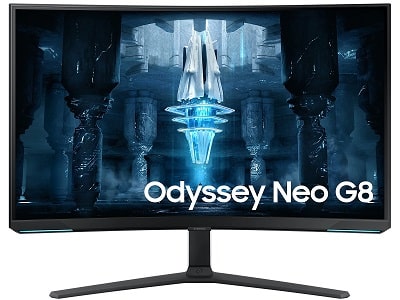Samsung Odyssey Neo G8 (S32BG85) 240Hz 4K VA with Mini LED
As an Amazon Associate and Newegg Affiliate I earn from qualifying purchases made using the “Buy” button at the bottom of this post. Where possible, you'll be redirected to your nearest store. Further information on supporting our work.HDR (High Dynamic Range) is a widely marketed feature on monitors these days, though the level of support varies significantly. The Samsung S32BG85 (S32BG850 or G85NB) of the Odyssey Neo G8 series aims to deliver a highly dynamic experience. Styling follows that of other models from the series, with a mixture of dark matte plastic and glossy white plastic. The top and side bezels are dual-stage, with a slim panel flush with the rest of the screen plus a slim hard plastic outer part. The bottom bezel includes customisable ‘Core Lighting’ LED cheeks at either side, configurable in the OSD (On Screen Display). This OSD is controlled by directional buttons which face downwards towards the central region of the bottom bezel.
The monitor uses a 31.5″ 3840 x 2160 (‘4K’ UHD) VA panel, based on the CSOT CY-PB315GLHV1H more specifically. This includes a steep 1000R curve, light matte anti-glare screen surface and has a 1m:1 (local dimming) contrast ratio plus 178°/178° viewing angles. The curve has been quite a contentious feature on Odyssey models in the past and in our experience with models of this size and curvature it can be quite a noticeable and defining feature at times. But it can also create a bit of extra immersion which some might appreciate. A 240Hz refresh rate is supported alongside Adaptive-Sync, including Nvidia’s ‘G-SYNC Compatible Mode’ and AMD FreeSync Premium Pro (VRR range currently unknown). The monitor adopts a Quantum Dot Mini LED backlight Samsung refers to as ‘Quantum Matrix’, with 1196 dimming zones and a 600 cd/m² typical maximum luminance. The monitor responds to HDR10 content with a peak luminance of 2000 cd/m² for some strong pulses of brightness, hence the manufacturer referring to this as ‘Quantum HDR 2000’. Not to be confused with VESA’s DisplayHDR certification levels; the Super UltraWide Neo G9 made similar claims, but both peak and sustained luminance levels in most situations fell well short of this. A similar colour gamut (~95% DCI-P3) is also specified for this model, which can be put to good use for HDR10 content alongside 10-bit colour reproduction.
The monitor has a 1ms grey to grey response time specified (caution advised), whilst an ‘MBR’ strobe backlight also features. The rear of the screen is largely glossy white plastic, with an ‘InfinityCore’ RGB LED lighting feature surrounding the stand attachment point. This can be customised with various colour options and flashing patterns in the OSD. The stand offers full adjustability and can be removed to make way for an alternative 100 x 100mm VESA compatible solution. The ports face downwards beneath a removable plastic cover and include; 2 HDMI 2.1 ports, DP 1.4, 2 USB 3 ports (plus upstream) and a 3.5mm headphone jack. The HDMI 2.1 connectivity allows games consoles such as the Xbox Series X and PS5 to run with a 120Hz ‘4K’ UHD signal.
Further details on the manufacturer’s website. The monitor is listed for ~$1500 USD (£1300) with a 165Hz Neo G7 variant (S32BG75) listed for ~$1300 USD (£1100). Further thoughts on the Neo G8 and Neo G7 can be found on our forum and also in our review of the Neo G7.



